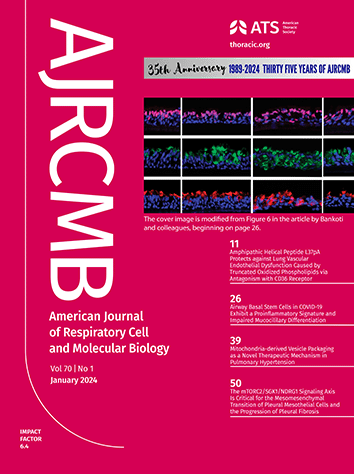Estrogen Oppositely Regulates Pulmonary Hypertension via METTL3/PFKFB3 Under Normoxia and Hypoxia.
IF 5.9
2区 医学
Q1 BIOCHEMISTRY & MOLECULAR BIOLOGY
American Journal of Respiratory Cell and Molecular Biology
Pub Date : 2024-09-12
DOI:10.1165/rcmb.2024-0042oc
引用次数: 0
Abstract
Despite extensive investigation into estrogen's role in pulmonary hypertension (PH) development, its effects-whether beneficial or detrimental-remains contentious. This study aimed to elucidate estrogen's potential role in PH under normoxic and hypoxic conditions. Utilizing norfenfluramine- and hypoxia-induced rat models of PH, the study evaluated the impact of 17β-estradiol (E2) on PH progression. E2 promoted PH development under normoxia while providing protection under hypoxia. Mechanistically, under normoxia, E2 upregulated methyltransferase-like 3 (METTL3) gene transcription and protein via an estrogen response element-dependent pathway, which in turn elevated the m6A methylation and translational efficiency of 6-phosphofructo-2-kinase/fructose-2,6-bisphosphatase isoform 3 (PFKFB3) mRNA, leading to increased PFKFB3 protein levels and enhanced proliferation and migration of pulmonary artery smooth muscle cells (PASMCs). Conversely, under hypoxia, E2 downregulated METTL3 transcription through a hypoxia response element-dependent mechanism, driven by elevated hypoxia-induced factor 1α (HIF-1α) levels, resulting in reduced PFKFB3 protein expression and diminished PASMCs proliferation and migration. Both METTL3 and PFKFB3 proteins are upregulated in the pulmonary arteries of patients with PAH. Collectively, these findings suggest that E2 exerts differential effects on PH progression via dual regulation of the METTL3/PFKFB3 protein under normoxic and hypoxic conditions, positioning the METTL3/PFKFB3 protein as a potential therapeutic target for PH treatment.雌激素通过 METTL3/PFKFB3 在正常缺氧和缺氧条件下对肺动脉高压进行相反调控
尽管对雌激素在肺动脉高压(PH)发展中的作用进行了广泛的研究,但其作用--无论是有益还是有害--仍存在争议。本研究旨在阐明雌激素在常氧和缺氧条件下对肺动脉高压的潜在作用。该研究利用去甲芬氟拉明和缺氧诱导的大鼠 PH 模型,评估了 17β-estradiol (E2) 对 PH 进展的影响。在常氧条件下,E2促进了PH的发展,而在低氧条件下则提供了保护。从机理上讲,在常氧条件下,E2通过雌激素反应元件依赖途径上调甲基转移酶样3(METTL3)基因转录和蛋白,进而提高6-磷酸果糖-2-激酶/果糖-2,6-二磷酸酶同工酶3(PFKFB3)mRNA的m6A甲基化和翻译效率,导致PFKFB3蛋白水平升高,增强肺动脉平滑肌细胞(PASMCs)的增殖和迁移。相反,在低氧条件下,E2 通过低氧反应元件依赖性机制下调 METTL3 的转录,而低氧诱导因子 1α(HIF-1α)水平的升高会导致 PFKFB3 蛋白表达减少,并降低 PASMCs 的增殖和迁移。在 PAH 患者的肺动脉中,METTL3 和 PFKFB3 蛋白均上调。总之,这些研究结果表明,E2 在常氧和缺氧条件下通过对 METTL3/PFKFB3 蛋白的双重调控对 PH 的进展产生不同的影响,从而将 METTL3/PFKFB3 蛋白定位为治疗 PH 的潜在治疗靶点。
本文章由计算机程序翻译,如有差异,请以英文原文为准。
求助全文
约1分钟内获得全文
求助全文
来源期刊
CiteScore
11.20
自引率
3.10%
发文量
370
审稿时长
3-8 weeks
期刊介绍:
The American Journal of Respiratory Cell and Molecular Biology publishes papers that report significant and original observations in the area of pulmonary biology. The focus of the Journal includes, but is not limited to, cellular, biochemical, molecular, developmental, genetic, and immunologic studies of lung cells and molecules.

 求助内容:
求助内容: 应助结果提醒方式:
应助结果提醒方式:


